Related Research Articles

Maasai Mara, also sometimes spelled Masai Mara and locally known simply as The Mara, is a large national game reserve in Narok, Kenya, contiguous with the Serengeti National Park in Tanzania. It is named in honor of the Maasai people, the ancestral inhabitants of the area, who migrated to the area from the Nile Basin. Their description of the area when looked at from afar: "Mara" means "spotted" in the local Maasai language, due to the many short bushy trees which dot the landscape.
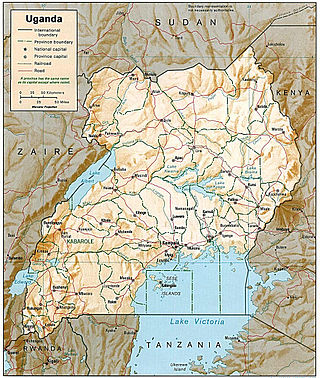
Transport in Uganda refers to the transportation structure in Uganda. The country has an extensive network of paved and unpaved roads.
Tsavo East National Park is a national park in Kenya with an area of 13,747 km2 (5,308 sq mi). It was established in April 1948 and covers a semi-arid area previously known as the Taru Desert. Together with Tsavo west, it forms an area of about 22,000 square kilometers. The Tsavo River flows west to east through the national park, which is located in the Taita-Taveta County of the former Coast Province.

The Shimba Hills National Reserve is a small National Reserve in the former Coast Province of Kenya, 33 km from Mombasa and 15 km from the coast. The reserve is an area of coastal rainforest, woodland and grassland. It is an important area for plant biodiversity – over 50% of the 159 rare plants in Kenya are found in the Shimba Hills, including some endangered species of cycad and orchids. It is also a nationally important site for birds and butterflies.
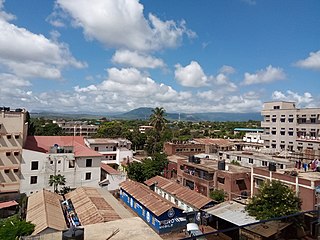
Voi is the largest town in Taita-Taveta County in southern Kenya, in the former Coast Province. It lies at the western edge of the Taru Desert, south and west of the Tsavo East National Park. The Sagala Hills are to the south.

Environmental issues in Kenya include deforestation, soil erosion, desertification, water shortage and degraded water quality, flooding, poaching, and domestic and industrial pollution.
Rail transport in Kenya consists of a metre-gauge network and a new standard-gauge railway (SGR). Both railways connect Kenya's main port city of Mombasa to the interior, running through the national capital of Nairobi. The metre-gauge network runs to the Ugandan border, and the Mombasa–Nairobi Standard Gauge Railway, financed by a Chinese loan, reaches Suswa.

Taita–Taveta County previously known as Taita Taveta District is a county of Kenya. It lies approximately 200 km northwest of Mombasa and 360 km southeast of Nairobi.Taita-Taveta County is located approximately 360 km southeast of Nairobi and 200 km northwest of Mombasa and is a port and major gateway to the United Republic of Tanzania through Taveta town. The County headquarters are located in Mwatate sub-county, which is one of the six counties in the Jumuiya ya Kaunti za Pwani regional economic bloc. Major towns include Voi, Taveta, Mwatate and Wundanyi
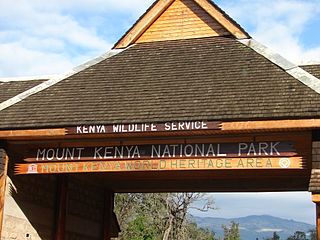
Kenya Wildlife Service is a state corporation under the Ministry of Tourism and Wildlife established by an act of Parliament; Wildlife Conservation and Management Act CAP 376, of 1989, now repealed and replaced by the Wildlife Conservation and Management Act, 2013. At independence, the Government of Kenya committed itself to conserving wildlife for posterity with all the means at its disposal, including the places animals lived, forests and water catchment areas.
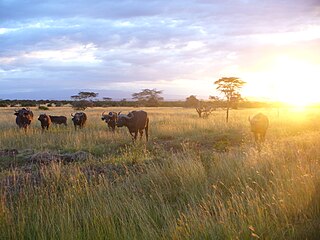
The wildlife of Kenya refers to its fauna. The diversity of Kenya's wildlife has garnered international fame, especially for its populations of large mammals. Mammal species include lion, cheetah hippopotamus, African buffalo, wildebeest (Connochaetes), African bush elephant, zebra (Equus), giraffe (Giraffa), and rhinoceros. Kenya has a very diverse population of birds, including flamingo and common ostrich.
Tsavo West National Park is located in the Coast Province of Kenya. The park covers an area of 9,065 square kilometres. The A109 road Nairobi-Mombasa and a railway divides it from the adjoining Tsavo East National Park. Together with adjoining ranches and protected areas, they comprise the Tsavo Conservation Area. Tsavo West is a more popular destination on account of its magnificent scenery, Mzima Springs, rich and varied wildlife, good road system, rhino reserve, rock climbing potential and guided walks along the Tsavo River. The park is operated by Kenya Wildlife Service.

The International Elephant Foundation (IEF) is a non-profit 501(c)(3) corporation. Formed by individuals and institutions, IEF is dedicated to the conservation of African and Asian elephants worldwide.
The African Wildlife Foundation (AWF) is the leading international conservation organization focused exclusively on Africa's wildlife and wild lands.

The Sheldrick Wildlife Trust operates an orphan elephant rescue and wildlife rehabilitation program in Kenya. It was founded in 1977 by Dame Daphne Sheldrick to honor her late husband, David Sheldrick. Since 2001, it has been run by their daughter, Angela Sheldrick.
Jim Justus Nyamu, of Nairobi, Kenya, is an elephant research scientist and activist against poaching and trade in ivory. Nyamu is the executive director at the Elephant Neighbors Center (ENC) and is leader of the movement, Ivory Belongs to Elephants. He has also held positions at the African Conservation Centre and Kenya Wildlife Service. The ENC is a grass-roots collaborative and participatory research organization focused on enhancing the capacity of communities living with wildlife to promote interlinkages between species and their habitats.
The Mombasa–Nairobi Standard Gauge Railway is a standard-gauge railway (SGR) in Kenya that connects the large Indian Ocean city of Mombasa with Nairobi, the country's capital and largest city. This SGR runs parallel to the narrow-gauge Uganda Railway that was completed in 1901 under British colonial rule. The East African Railway Master Plan provides for the Mombasa–Nairobi SGR to link with other SGRs being built in the East African Community.
The Nairobi–Malaba Standard Gauge Railway (SGR) is the project of standard-gauge railway that should connect Kenya's capital city of Nairobi to Malaba, at the international border with Uganda. The Nairobi–Malaba SGR was to connect other standard gauge railways in Uganda, Rwanda, Burundi, South Sudan and eastern Democratic Republic of the Congo, under the East African Railway Master Plan.
Big Life Foundation is non-profit conservation organization focused on preserving the wildlife and habitats of the Amboseli-Tsavo-Kilimanjaro ecosystem of East Africa through community-based and collaborative strategies.
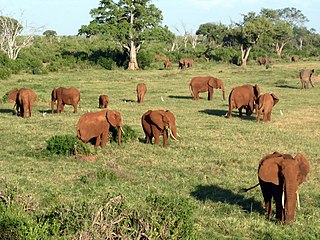
The Northern Acacia–Commiphora bushlands and thickets are a tropical grasslands, savannas and shrublands ecoregion in eastern Africa. The ecoregion is mostly located in Kenya, extending north into southeastern South Sudan, northeastern Uganda and southwestern Ethiopia and south into Tanzania along the Kenya-Tanzania border.
References
- 1 2 "Tsavo Trust - An OverviewTsavo Conservation Area". tsavotrust.org. Retrieved 21 May 2017.
- 1 2 3 4 Games, Ian. Tsavo Conservation Area Management Plan 2008-2018 (Report). Nairobi: Kenya Wildlife Service. p. 6-8.
- 1 2 "Tsavo Conservation Area - Where We Work - Amara Conservation". amaraconservation.org. Retrieved 21 May 2017.
- ↑ Koskei, M., Ben Okita-Ouma, F. Lala, Dennis Kibara, L. Tiller, Lucy King, Frank Pope, and Iain Douglas-Hamilton. ‘The Effect of the New Standard Gauge Railway (SGR) on Elephant Movements in Tsavo Ecosystem, Kenya (March 2016 – March 2018)’. Nairobi: Save the Elephants / KWS, 2018. https://www.savetheelephants.org/wp-content/uploads/2019/01/2018%20Tsavo%20tracking%20and%20monitoring%202%20year%20report%20final_web.pdf.